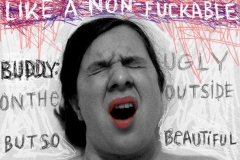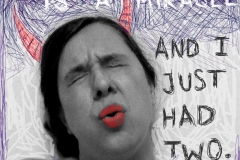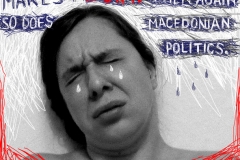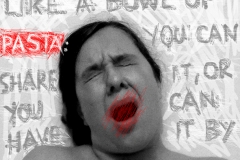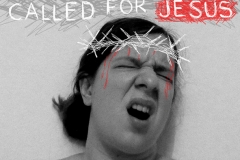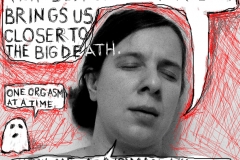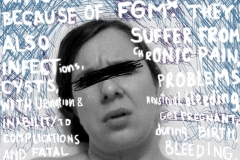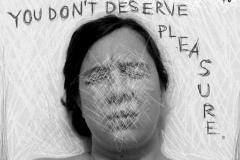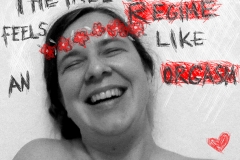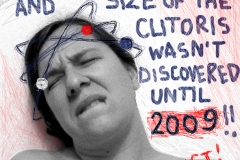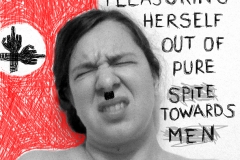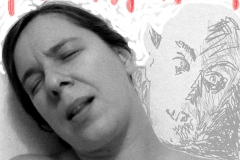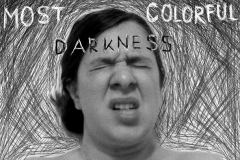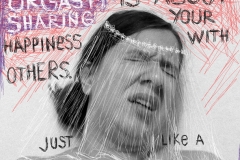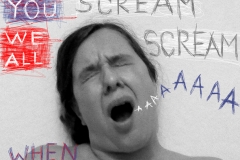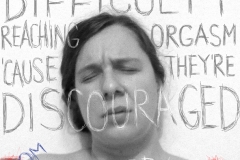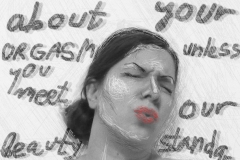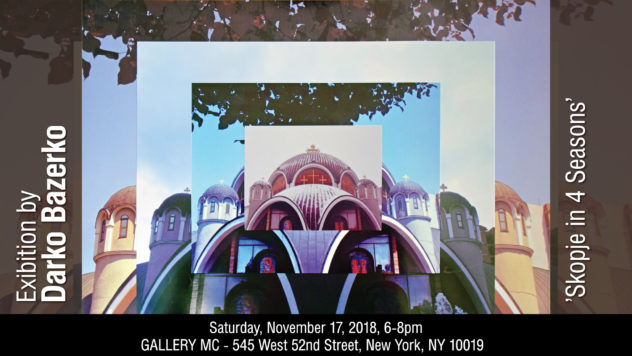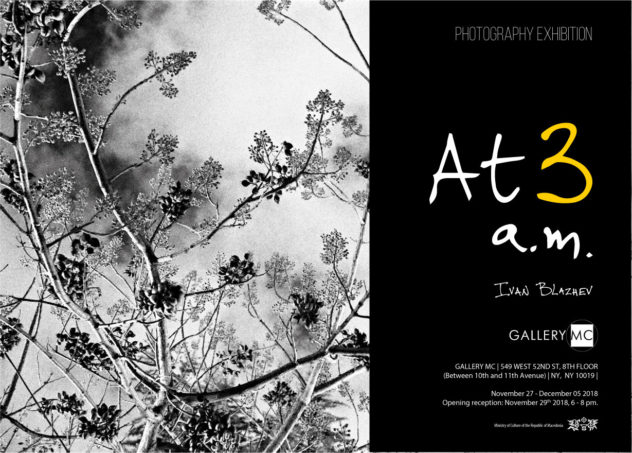O as in orgasm or a celebration of life by Artist in Residence Jana Jakimovska
O as in orgasm or a celebration of life
The works of Jana Jakimovska – regardless of how powerful, intense and striking they are – will undoubtedly provoke a deafening silence in this muddy cultural puddle of ours crusted with the debris of civilization, where occasionally what surfaces is the pungent gas of the bloated stomach of the national body, asleep for centuries. Unquestionably, these works will arouse attention in those few who challenge this provincial drowsiness, this voluntary backwardness (in every respect), this pristine tranquility of our woeful puddle. However, these are merely superficial ripples that define the place, but not the significance of Jana Jakimovska’s works.
The alluring offer to peak into the bedroom of the artist at the moment when “the mysteries of the organism” occur, the fascination of stripping while someone watches, the emphatic images of the spectacular emotional kaleidoscope, the forbidden pleasure spiked by observing another one’s intimacy, the lucid comments of the author, her self-irony and humor – beneath all the affects and affectations, like tar emerging from the back of the mirror (its back is the churning amalgam of our desires), Jana Jakimovska’s works in fact reveal far deeper truths.
Contemporary society revolves around the body. The human body is a “desiring machine” (Deleuze) and man today is an object reduced to desire itself – a body-machine that produces at the behest of the set social code (buried deep inside the conscience). The production of desire is fully aimed at satisfying physical lust. The general erotization of the world (the erotization of the human body, but also everything else – from cars to public buildings) ends with its own negation as pornography.
After the orgies of the modern epoch and the liberation of desires (all desires), we have taken a step forward towards the trans-sexual, in the sense of sex being transparent, in a world of symbols and images that invalidate all secrets and ambiguities. Sex and death are reduced to banal chemical processes where bodily fluids are exchanged and human cells die. For us, there are no more secrets.
Our world is a pornographized world. If, according to Baudrillard, the illusion of desire has been lost in pornography, in contemporary art it is the desire for illusion that has been lost. Pornography leaves nothing to desire. In such a pornographized world, Jana Jakimovska’s works are subversive because they reaffirm desire (physical: 200,000,000 women have difficulty reaching orgasm; metaphysical: If every orgasm is a tiny death, then maybe it brings us closer to the big death; aesthetic: My orgasm is like a non fuckable buddy: ugly on the outside but so beautiful on the inside; ethical: You are nobody. You don’t deserve pleasure; political: The fall of the regime feels like an orgasm; etc.)
The dramatic appearance of Eros in the world is a subversive occurrence. Freud reveals the self-destructive nature of civilization. Culture imposes sublimation, with which it weakens Eros, who in fact builds that culture. The successful control of sexuality (the demand of every culture), the repression and desexualization of society through the weakening of Eros (the life instinct) enables the strengthening of Thanatos (the death instinct), creating room for its destructive actions. Thus civilization falls under the influence of Thanatos and the death instinct prevails over the life instinct. Based on denial and developed through progressive denial, civilization strives towards self-destruction.
Eros unchecked is just as dangerous as Thanatos, the death drive. Its destructive power stems from its impulse to gratify what society cannot afford to gratify. Thus, the drive needs to be redirected, stopped in its intention to be fully realized. Civilization begins where the drive gives way. Freud describes this as the transformation of the pleasure principle into the reality principle. The pleasure principle and the reality principle are opposing concepts. The repressive organization of the drive forms the base of all the historical forms of the reality principle.
Thus, art today is destructive, pornographic, banal, void of meaning, carnal, cadaverous… it is the dance of death, Danse Macabre, over the world in agony. It celebrates the world of death, perceiving the manifestation of Beauty, Good and Truth as hostile attacks. Hence, Jana Jakimovska’s works are political works.
In contrast to the death of Eros, in contrast to death itself, Jakimovska’s works are a cry in the darkness and coldness of this world. A cry for Eros. A cry of pleasure and celebration of life against death (against death as death). The orgasm (la petite mort; the little death) is taken as the moment when the bodily is overcome, when the unseen becomes seen and the soul travels in the realms beyond the senses, in the realms liberated from the body. This is the moment when the ugly becomes beautiful. When the beautiful is manifested in matter, causing the body to experience an orgasmic satisfaction.
It concerns being who you are, in your intimacy, in the light, in the glimmer of truth and the pure vision of what is beyond the senses. It is this victory over the bodily, over the perishable and disintegrating body – in the eternity of the moment – that allows the beautiful to be manifested in the ugly, the repulsive, the grotesque, in the general entropy of the forms or in the face of a woman having an orgasm.
Jakimovska’s works unite two opposites – life and form – which define the opposites within whose limits art pulsates. Here the desire for a full and vigorous life (living life to its fullest) with the experience of transcendence which transcends the continuous flow of life.
The orgasm – the beginning and end of the bodily – marks the moment when the body and the bodily are annihilated. Seemingly paradoxically, however full of life they are, however much they represent a celebration of life, of the bodily, however much they are an orgasmic climax of life itself, the works of Jana Jakimovska are works of death. In their opposition to death, they expose death. The language of life is always the language of death. Hence, these works are metaphysical (leaving aside Spinoza and the humor that protects the artist – these works are as serious as the orgasm itself).
With its homemade photo sincerity (a brutal outburst of desire and sexual pleasure in the world of the trans-sexual kitsch spectacle) and its lucid comments, this intelligent work of art opens a series of significant questions about the relationships between the individual and society, the private and the public, the body and mind, the beautiful and the ugly, life and form, sex and death… Seemingly reduced to a joke, a provocation or a place where one can enjoy a glance into someone else’s intimacy (the work, in fact, disables the civil enjoyment in the idealized erotic body as the object of desire), Jana Jakimovska’s work publicly exposes the sizzling games with the body of politics, of power and of sexto their boiling point and evaporation in a trans-political, trans-human and trans-sexual world. This work of art is an artistic manifest of the resistance towards the culture of death.
Emil Aleksiev

